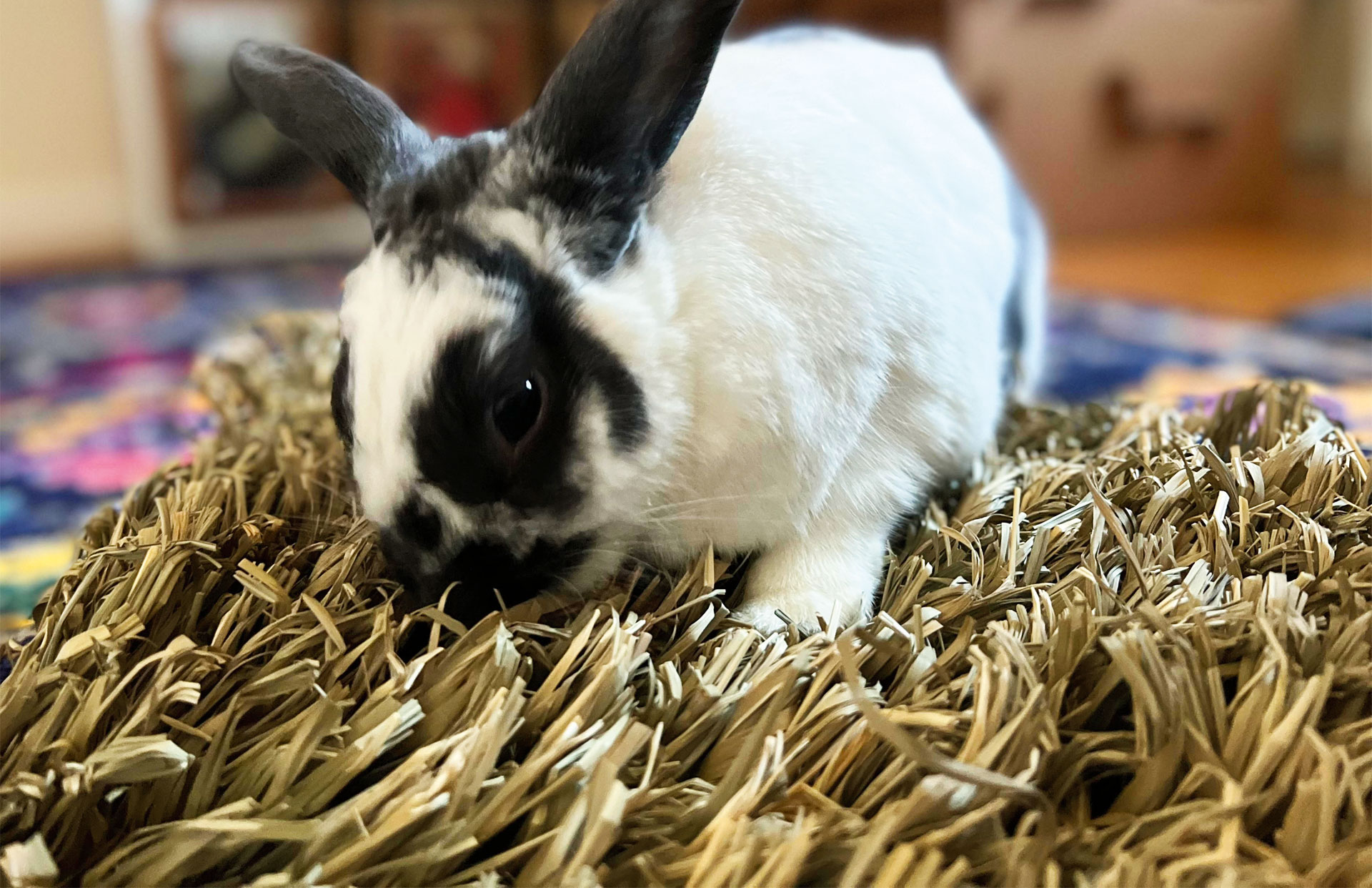The concept of foraging has been gaining popularity and interest among pet parents, and for great reason. When supported in healthy and meaningful ways, foraging is a beneficial and instinctual activity for all small animals, including rabbits, guinea pigs, chinchillas, rats, hamsters, and so on. As “foraging” becomes a popular marketing term attached to small animal products, ranging from daily diets to habitat accessories, it’s become clear that not all foraging products are created equal. Furthermore, research has shown that some of these products (such as “forage blend” diets) can have negative health impacts on small animals.
The good news for pet parents is that they can successfully support their pets’ foraging instincts in a variety of healthy, interactive ways that offer the added benefit of helping to build the bond with their pets. To help you set you and your rabbit up for a successful foraging experience, let’s take a closer look at the following important questions.
What is foraging? Why do wild animals engage in foraging behaviors?
Simply put, foraging refers to the act of searching widely for food. Rabbits and other small animal species explore their wild surroundings daily in search of sustenance in the form of grasses, clover, wildflowers, and even less nourishing options like twigs and bark when necessary. This instinctual activity is directly tied to an animal’s ability to survive in the wild. In native environments that can be very sparsely vegetated, animals have no choice but to search far and wide for sustenance.
Is foraging important for domesticated rabbits?
While their wild cousins engage in daily foraging as a means of survival, most of our pampered rabbits have the great fortune of having their daily nutrition delivered on the equivalent of a silver platter. Food for our rabbits is predictable and guaranteed, oftentimes with little to no foraging required. Without having to forage as a necessity, the instinct to hunt for sustenance fades and, in the process, most rabbits miss out on the substantial benefits linked to this instinctual activity. These benefits include daily physical and mental enrichment, two important contributors to overall health and wellbeing in rabbits. The good news is that foraging instincts never completely go away, even if they’ve never been properly fostered. With a proper environment and proper support, rabbits will instinctually engage in beneficial foraging behaviors.
What are foraging mixes? Do they really promote foraging in a healthy way?
In recent years, the market has welcomed a number of small animal foods marketed as “forage mixes” or “forage blends.” The specific ingredients in these products vary, but what they all have in common is they contain a variety of components and are marketed with the claim they encourage the natural favoring behaviors of small pets. But, do these products deliver on these claims?
- Selective feeding: where mixes miss the mark
For many of the same reasons that small animals instinctively forage in their native environment, prey species such as rabbits and others are wired to consume the most calorically dense nutrition available first. This behavior (also known as “concentrate-selecting”) is directly tied to the survival instinct. By consuming as much energy as possible (as quickly as they can) small animals are more likely to meet their daily calorie requirements while surviving the imminent threat of predators.
Fast forward to life in the average cozy two-story or apartment. There are no coyotes or raptors to be seen (we hope!), but the instinct to selectively feed remains hard-wired in our beloved house-dwelling rabbits. So, what does this mean? It means that, when offered a mix-based diet, most rabbits will selectively eat the most calorically dense (and, unfortunately, least nutritious) components first. This includes ingredients like dried fruits, nuts, and seeds—which should not be fed to rabbits, except for fruit, which should only given as an occasional treat. - The nutritional impact of selective feeding
Not only do forage mixes fail to inspire meaningful foraging behaviors, but many of the popular options are also nutritionally imbalanced at a formula level—too high in starch and too low in fiber to support the unique digestive tracts of small mammals like rabbits.
When rabbits selectively eat the least nutritious components from these foods, they leave behind a majority of the high-fiber, vitamin, and mineral-rich pellets. This exacerbates nutritional imbalances, leading to potential micronutrient deficiencies in the process. To make matters worse, feeding mixes has been shown to result in rabbits consuming less hay and drinking less water, increasing changes of digestive, dental, and bladder issues.
What’s the best way to inspire instinctual foraging behaviors in rabbits?
The primary goal with foraging is to encourage rabbits to move in search of components of their daily nutrition. With that in mind, there are many great ways to inspire your rabbit’s instinctual foraging behaviors in healthy ways. In addition to the direct benefits to rabbits, many of these activities offer the bonus of helping build the ever-important bond between rabbits and their caretakers.
- Ready to promote foraging? Start simply with hay!
Fresh grass hay should always be available in unlimited amounts for small herbivores, ideally in multiple locations in and around the habitat. Many rabbits will instinctually forage within their hay. Oat hay, for example, often contains tasty seed heads that rabbits love seeking out. In addition to foraging in the process of eating their daily hay, many rabbits will take the opportunity to burrow inside. - Offer a variety of hays to stimulate foraging daily
Beyond the basics of offering hay daily, everyone’s favorite high fiber staple can be used in other fun and enriching ways to promote foraging. Simply offering a variety of hays is a great way to stimulate instinctual foraging in rabbits. Interacting with a variety of tastes and textures is a great way to engage a rabbit’s senses while encouraging them to physically interact with their hay every day. - Forage with food the right way
While mix-based foods miss the mark on promoting meaningful foraging, there are still some great opportunities to utilize nutritionally appropriate fortified food to inspire this instinctual behavior. Some easy, effective ways to encourage rabbits to forage for their food include:- Scatter feeding: A simple, effective approach to foraging
Scatter feeding is an effective and enriching way to encourage rabbits to physically and mentally work for their food. This activity is as simple as spreading a rabbit’s daily food out over a greater surface area to force them to spend more time and energy to locate and consume it. Scatter feeding can be especially beneficial for rabbits who are inclined to eat too quickly. - Hide nutritious food in engaging locations throughout the habitat
A rabbit’s food doesn’t need to include sugary dried fruit or mystery bits to be enticing. Small animals will hunt for their food instinctually, experiencing valuable mental and physical enrichment in the process. Most rabbits enjoy utilizing their highly perceptive sense of smell to locate and happily consume their uniform pellets in hidden locations, such as within a pile of hay or at the back of their hide space.
- Scatter feeding: A simple, effective approach to foraging
- Use enriching accessories to promote foraging
As we’ve discussed, the act of foraging is directly tied to survival for animals living in the wild. In the domesticated home setting, however, foraging can be considered a direct form of enrichment. The good news for rabbit parents and their furry friends is there are a growing number of fun and exciting accessories specially designed to encourage foraging and make the activity enjoyable for rabbits and rabbit parents alike.- Forage bowls: helping rabbits slow down at mealtime
For rabbit parents who like the idea of scatter feeding but are concerned about their rabbit’s food getting soiled or lost, forage bowls are a great option. These bowls are specially made with safe, rounded nubs designed to slow down the feeding process. - Enriching feeders: adding motion to every meal
“Pet-powered” accessories like a treat ball are great for adding physical activity and mental stimulation to the act of eating. Food is dispensed gradually when rabbits roll or push these items, making them the poster items for the motto “will work for food.” Adjustable openings allow rabbit parents to control the flow of food. - Hide & seek mats: high fiber foraging at floor level
Dog owners are likely familiar with the enriching benefits of snuffle mats, which are often made of fleece and designed to stimulate pets to forage for food or treats. Oxbow’s Enriched Life Hide & Seek Mats are designed with the same goal in mind, with the added, species-appropriate benefit of being made of 100% timothy hay. For fiber-loving herbivores like rabbits, this is a win/win. As rabbits hunt for food or treats, they will enjoy and benefit from munching on the mats themselves. - Puzzles, games, and more!
There are a wide variety of additional accessories that can be used each day to support the beneficial foraging instincts of rabbits and other small pets. Accessories with lids or drawers can be filled with rewards in the form of food and are great for stimulating rabbits mentally. Similarly, species-appropriate, hidey houses and tunnels made of hay or willow make a great option for hiding food and treats inside a generous pile of hay and provide the added benefit of providing a safe place to engage the natural hiding instinct while foraging for food.
- Forage bowls: helping rabbits slow down at mealtime
Lets Get Foraging
Looking for some fun items to give to your rabbit to encourage their foraging instinct? Give these a try! You can also ask your local HRS chapter or rabbit rescue what other foraging toy recommendations they have that they’ve seen rabbits like. Searching Etsy to find products created by small business owners is also a great option.
There are also plenty of simple toys you can make at home to encourage your rabbit to forage, too, such as stuffing a toilet paper roll with hay and a few pellets or a small treat inside for your rabbit to discover.
- Binky Bunny’s Seagrass Bowl
- Binky Bunny’s Triangle Folding Tunnel
- Living World’s Teach ’N Treat Toy
- Oxbow’s Enriched Life Wobble Teaser and Rolly Teaser
- Oxbow’s Timothy Club Hide & Seek Small Pet Mat
- PetSafe’s SlimCat Interactive Feeder
- Small Pet Select’s Birch Logs
- Small Pet Select’s Small Hay Manger
- The First Years’ Stack ’N Count Cups
- Tokihut’s Veggie Foraging Mat

Reviewed by HRS staff
Author: Micah Kohles, DVM, MPA, Veterinary Medical Officer and Vice President of Consumer Services and Education, Oxbow Animal Health/ Compana Pet BrandsJournal Issue: House Rabbit Journal, Winter 2022





